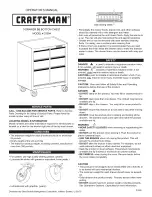
5
Strong Enterprises Owner’s Manual. Para-Cushion
www.strongparachutes.com [email protected]
air flow than conventional parachute fabric and therefore provides a slower, more stable rate of descent.
1.6 System Function
The Para-Cushion is activated by pulling the ripcord handle. This withdraws the ripcord pins and
releases the locking loops allowing the pilot chute to eject, catch air and extract the parachute canopy
from the container. A “diaper” is sewn to the skirt at the bottom of the canopy. On deployment, the
canopy and suspension lines are extracted from the container. The diaper is released as the last
stows deploy, allowing the canopy to inflate.
Typically, it takes about 2 to 3 seconds from ripcord pull to fully inflated canopy, traveling a vertical
distance of 150 to 300 feet. This does NOT mean that you should plan on jumping or pulling at 300
feet. Deployment time and distance depend on, among other factors, your airspeed.
1.7 Care of Your PCS 304 Emergency Parachute System
Observe these precautions to maximize the service life of your Para-Cushion Emergency Parachute
System. Parachutes are simultaneously very rugged and quite delicate. They are life saving devices
and should be treated with great care. Parachutes are made of nylon, a very strong and durable, but
not invincible, material. Nylon is deteriorated by small amounts of acid and weakened by ultraviolet
sunlight. These surface effects do not seriously influence thicker materials, such as webbing or pack
material, but canopy cloth is very vulnerable. If your Para-Cushion is opened or used, it should be
taken to a certificated parachute rigger, or returned to the manufacturer for airing, drying, inspection
and repack. FAA FAR 65.129 requires that no parachute be packed, maintained, or altered in any
manner that deviates from procedures approved by the manufacturer.
The parachute should be left unopened inside its protective container until ready for use. When you
take your Para-Cushion to your rigger for servicing, they will be glad to allow you to pull the ripcord
yourself, give you a functional demonstration, and answer all your questions. We urge you NOT
to open your parachute in the field for demonstration purposes. Foreign objects can cause costly
damage the canopy.
When your Para-Cushion is in the aircraft, care must be exercised to ensure that it is not damaged.
Be sure that it does not come in contact with any sharp or loose metal surfaces, or any objetcs within
the plane, which might cut or snag it. All metal edges, exposed nuts and bolts, etc. should be taped
or covered to prevent wear on the parachute container. Be sure that your parachute does not come
in contact with water, oils, acids, grease, dirt, agricultural or fire retardant chemicals.
For long term storage the best possible way to store your canopy is unopened inside the carry bag.
It doesn’t matter how long the canopy is kept that way. If you open your para-cushion there are
more opportunities to damage the canopy or lines. If you decide that you must open it and remove
the rubber bands we suggest putting both canopy and lines directly into the cloth bag (laundry
bag, pillow case). The reason we don’t recommend a plastic bag is that nylon “breaths”. Or more
specifically it will absorb and release moisture and stabilize to the ambient humidity levels. If it is
trapped in a plastic bag there is more opportunity for mold/mildew to grow, while a cloth bag allows
the breathing process to continue.
! WARNING !
Leaving your packed parachute system exposed to the sun
will greatly decrease its service life.
1.8 Service Life
FAA FAR 65.129 requires that “No certificated parachute rigger may pack a parachute that is not safe for






































